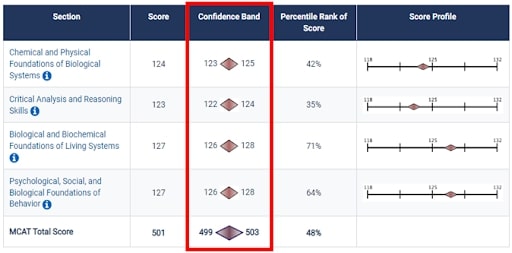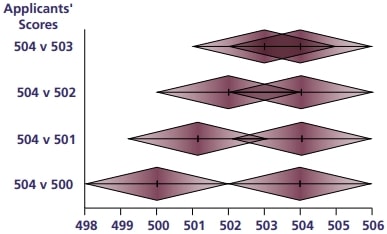As you study and prepare for the MCAT, learning and reviewing the different concepts required could be challenging and overwhelming. However, aside from the different topics that you have to learn and review, it is also essential that you are aware of how the MCAT scoring works.
It is critical for you to comprehend the components of your MCAT score report and the admissions committees, who will use it to assess your readiness for academic success in the medical school curriculum.
This article will tell you what the MCAT confidence band is, one of the details you will find on your MCAT score report. To know more about the MCAT confidence band, please continue reading.
What is the MCAT?
Unquestionably, one of the most important tests for entrance to medical schools is the MCAT (Medical College Admission Test). This standardized computer-based multiple-choice exam is required for admission to almost all medical colleges in the US and Canada.
Medical schools can evaluate and compare an applicant's qualifications and preparation for medical school using criteria provided by the AAMC (Association of American Medical Colleges), which oversees the MCAT. In addition, admissions committees evaluate the level of your academic background based on your MCAT score and GPA.What are the Four Sections of the MCAT?
There are four sections to the MCAT. The first three parts of the exam will test your understanding of scientific concepts in organic chemistry, general chemistry, introductory biology, introductory physics, psychology, biochemistry, and sociology.
The last portion will evaluate your reading, understanding, and interpretation skills about social sciences and humanities.
How is the MCAT Scored?
The total number of questions you answer correctly determines your raw scores on the four multiple-choice sections of the MCAT exam. Your score is unaffected by incorrect responses, which are assessed similarly to unsolved questions.
Even if you are unsure of the correct response to a question, you should offer your best estimate because there is no additional penalty for incorrect replies.
Each section's number of correct answers is transformed into a scaled score ranging from 118 (lowest) to 132 (highest).
Your converted score, for instance, can be 125 if your raw score on one of the sections is between 32 and 36.
A converted score of 130 might be assigned to a number accurate score between 53 and 55, and so forth.
Since any difference in difficulty level is considered when computing your scaled scores, your performance on the MCAT exam is not dependent on the specific form you used, the group of test takers you were paired with, the test date, or the time of year.
What are MCAT Confidence Bands?
Sample MCAT Score Report
The highlighted part shows the confidence band of the candidate.
MCAT results, like other assessments, do not accurately reflect test takers' genuine levels of preparedness. As a result, they are not entirely accurate.
Examinees' scores may be negatively impacted by variables including exhaustion, exam anxiety, and unfavorable testing conditions or positively impacted by recent exposure to some of the topics being assessed.
Confidence bands describe the accuracy of the overall and section MCAT scores. They display the parameters in which test takers' actual results probably fall. It is crucial to disclose score precision information in score reports and to consider this accuracy when using scores to influence decisions.
MCAT confidence bands are represented graphically and mathematically in the MCAT score reports.
MCAT section scores are provided with plus or minus one-point confidence bands, whereas the MCAT total scores are presented with a plus or minus two-point confidence interval. For example, a total score of 501 and an associated confidence band, which spans scores of 499 to 503, are displayed in the graph above.
According to the diamond shape, the reported score is the most accurate assessment of an applicant's true score, which also graphically displays the MCAT confidence band.
The diamond's center, where it is tallest and the shading is most resounding, contains the recorded score.
What is the Purpose of the MCAT Confidence Bands?
The concept of the MCAT confidence bands may seem a little complicated.
However, the MCAT confidence bands should ultimately be to your advantage. If there is anything that sets your application apart from others, you may be sure that the admissions committee will not be able to use that against you in favor of other applicants.
You may have an actual score closer to the higher number in the MCAT confidence band than the other applicants, leveling the playing field.
If you earn a score of 127 on your CARS section, for instance, with an MCAT confidence band of 126–128, it suggests that, after accounting for the grading system's shortcomings, your true score was likely between 126 and 128. This makes it easier for medical schools to determine your true performance after accounting for the limitations of standardized testing.
This system also encourages medical schools to compare applicants who received scores close to one another.
They would be included in the confidence band of 126–128 if one student received a score of 128 on their CARS portion while another received a score of 126. This demonstrates to medical schools that, despite what the applicant's raw scores might suggest about their overall performance, there is no difference.
The "actual scores" could be inaccurate or "likely lie," which would make the MCAT confidence bands helpful to the students.Comparing Scores of Two Students Using the MCAT Confidence Bands
*Confidence bands overlap for scores that are more closely spaced.
It is crucial to consider how much the MCAT confidence bands of two applicants overlap when comparing their scores.
MCAT confidence bands overlap when scores are close together. The significance of the disparities in the scores decreases as confidence band overlap increases.
In the graph above, four pairs of MCAT total scores are shown with confidence bands that vary in how much they overlap.
For example, on a scale of 100, the top pair's scores, 504 and 503, are only separated by one point.
The figure demonstrates that the MCAT confidence bands for these scores overlap at the 502, 503, 504, and 505 score points.
The results in the bottom pair, 504 versus 500, differ by four points on the MCAT total score scale, and their confidence bands only overlap at the score of 502, showing that they are less compared to one another than the scores in the top pair.
Additional Reading:
Additional FAQs – What are MCAT Confidence Bands?
Does the MCAT Confidence Band Matter?
Confidence bands are used to highlight the unreliability of test results and prevent comparisons of candidates with similar test results.
Do Medical Schools Look into Your MCAT Confidence Bands?
The MCAT confidence bands enable medical schools to assess your performance more accurately after considering the limits of standardized testing.
Additionally, this system encourages medical schools to contrast candidates with comparable test results.
During your medical school application, verify your MCAT confidence bands to ensure your actual score falls within the range of averages that your desired medical schools will accept.
Be aware that the MCAT confidence band that contains scores on edge might not be favorable to your application.




 To help you achieve your goal MCAT score, we take turns hosting these
To help you achieve your goal MCAT score, we take turns hosting these 















